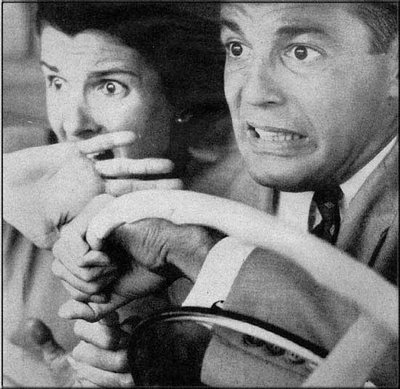7 In-Car Fixes that Can Help You Beat Car Sickness for Good

Feeling pukey during a car ride is a major pain in the butt (and the stomach!).
Wouldn’t it be nice to finally gaze at the landscape or read Harry Potter without feeling dizzy and nauseous? Wouldn’t it give you peace of mind knowing your kids don’t need a pitstop to calm their turbulent tummies?
Now we’re not physicians, so we’re not going to prescribe any medicines or fancy treatments to you.
The fixes we’ll recommend to conquer your car sickness are actions you can take in your car. Best of all, they require minimal effort or expense.
Where Car Sickness Comes From
The world’s medical geniuses aren’t 100% sure what causes car sickness, but evidence points to a disconnect between the senses and the brain, predominantly in the visual (eyes) and vestibular systems (inner ear).
Researchers think motion sickness occurs when the inner ear and eyes tell your brain two different messages. For example, the inner ear says “you’re moving”, while the eyes say “no, you’re not,” or vice-versa.

Abinash Virk, Director of travel and tropical medicine clinic at Mayo Clinic in Rochester, Minnesota, elaborated on the effects of this glitch. Virk says “When one of these is telling you you’re in motion and the other one is telling you you’re sitting, the brain gets confused with the mixed signals, and it causes this sense of sickness”.
What puts passengers at risk for car sickness?
- Genetics – Researchers believe some genes may wire certain people to have sensory glitches or oversensitivity to motion.
- Toxins – Exposure to certain toxins can set the vestibular system off balance.
- Age – Children aged 2 – 12 are more likely to experience motion sickness.
- Women – Women are more likely than men to suffer car sickness, especially if they are menstruating, pregnant or experiencing hormonal fluctuations.
- People with pre-existing conditions – Sufferers of migraines and vertigo are more likely to face motion sickness.
Now there’s good news despite what you’ve read above.
“You can’t change your body’s sensitivity to car sickness, but you can overcome it by travelling smart.”
Crushing Car Sickness
1. Minimize the sharp movements
Excess movement will only aggravate motion sickness. If you’re a driver, avoid movements such as unnecessarily sharp turns, or sudden acceleration/braking, as this will likely trigger those unwanted spells of dizziness and nausea.
Also, try to ride out bumpy roads in a smooth fashion – the ups and downs of uneven roads can send the stomach into an uproar.
If you’re a passenger, encourage your driver to follow these protocols.
2. Keep your eyes fixed
Wanna know why drivers (yourself included) rarely get car sick? Because they must fix their eyes ahead. That in itself reduces motion sickness.
When you fixate your eyes on a set point, it gives your brain a reference, allowing it to gain a sense of movement. Naturally, that will allow your eyes and inner ear to work in unison, suppressing the effect of the glitch.
Recommend this to your passengers if they are the ones suffering. It may pose a challenge to get a squirming toddler to focus on one point, but it’s certainly good advice for older kids and adults travelling with you.
3. Choose the right seat
It helps to be the driver. Of course, that’s not always possible (in the case of kids under 16), but the front passenger seat is still available to you.
Here’s the deal: sitting up front reduces your body’s sensitivity to motion, much like it would on a plane.
Additionally, sitting up front brings the inclination look ahead like the driver does, so that you can fix your eyes straight ahead (see previous point).
4. Keep your car ventilated
A natural response for someone feeling sick is to step into a cool space or outside. Of course, you can’t do that while driving, but you can keep your car properly ventilated.
Hot, dry air tends to worsen dizziness and nausea, so if you or a passenger of yours has this problem, good ventilation is important. Roll your window down to let the breeze in, or turn up the air condition to cool off the temperature in your car.
5. Throw on a weighted vest or wristband
Some individuals experience motion sickness due to developmental disorders – children with autism are perfect examples of this. The use of a weighted vest can reduce the vestibular sensitivity that causes sickness in autistic children.
Even for those who are neurotypical (a fancy word for having a normal nervous system), other wearable accessories work as well. An acupressure wristband is a good example of this. Although some say these wristbands aren’t all too effective, a large number of people have found that they do reduce the symptoms of car sickness.
6. Find a therapeutic distraction
The anticipation of motion sickness or thinking too much about it can worsen the symptoms. How do you take your mind  off of it?
off of it?
For starters, experts recommend listening to music, preferably a genre or style that relaxes you and promotes positive feelings.
What you listen to is up to you, but the combination of melodies, vocals and lyrics in your favourite tunes could very well take your mind away from the thought of motion sickness.
This goes for your passengers as well. You might not share their taste in music, but perhaps allowing them to sync their phone so they can play their tunes, will give them some relief from their car sickness.
7. Soothe the stomach
When you can’t distract yourself from nausea, the best thing to do is tackle it head on. We’re not doctors, so we can’t tell you what medication is best, but there are some non-pharmaceutical remedies that we can mention.
Ginger is a proven treatment for upset stomachs. Therefore, if motion sickness is an ongoing problem for you or someone you love, make sure to keep some ginger candies in your car (or on you). If you start to feel queasy, you can pop for relatively fast relief.
Peppermint can also treat car sickness. If ginger is too intense for you, then a peppermint candy can also do the trick of relieving an episode of nausea on the road.
Get Your Land Legs
Yes, car sickness is a real bummer. It can ruin an otherwise enjoyable and memorable road trip, and cause a you or someone you love to hate driving. But it doesn’t have to stay that way.
In combination with treatment from your doctor, implementing the right driving habits can reduce the headaches (literally and figuratively) that car sickness brings. Make these tricks a habit, and there’s a great chance that you’ll learn to love the road.






